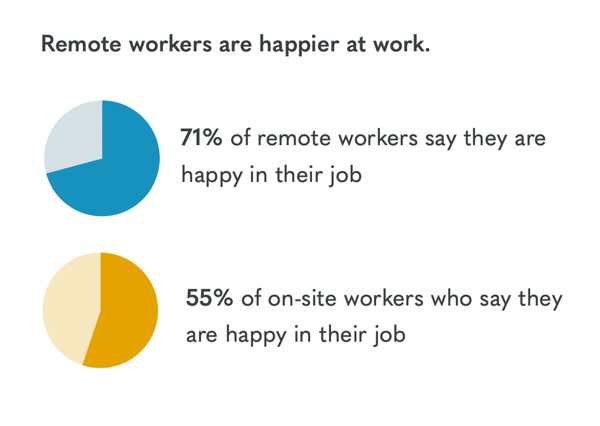Remote work is the way of the future — and the future is here.
Companies around the world have embraced the work from anywhere movement and offer remote work options. Employees value the flexibility to work from locations other than the office and they work remotely more frequently.
Even though the practice of remote work has evolved over the years, many leaders don't know enough about how remote work would impact their employees, teams, and organizations to enable it.
With the evolution of remote work in mind, it's our pleasure to introduce the 2019 State of Remote Work report!
The State of Remote Work is a yearly benchmark report where we examine how companies and industries are adapting to the growth of remote work and hybrid teams to learn where we've made progress and where we have room for improvement to embrace and empower location-flexible work.
Why did we create this report? At Owl Labs, we believe employees should be able to work from anywhere with the right technology and team support in place. We're on a mission to make location irrelevant for remote workers and hybrid teams.
As a hybrid company ourselves, we've seen firsthand how remote work can improve employee productivity, increase employee retention, and make employees feel more trusted and better able to balance work and life responsibilities.
With the results of the 2019 State of Remote Work report, executives, managers, and individual contributors alike can make a case for embracing remote work, which makes for happier employees and more productive teams.
Last year's Global State of Remote Work report shared findings on global remote work trends, but this year, we focused our research on the United States and partnered with workplace researcher, Kate Lister, president of Global Workplace Analytics, to ensure our approach was sound and our interpretations were grounded.
To better understand the state of remote work, we surveyed 1,202 full-time workers in the United States between the ages of 22 and 65. We asked them questions about:
- Demographics (Remote Work Frequency, Industry, Departments, Salary, Tenure)
- Employee Happiness, Loyalty, and Retention
- Top Reasons for Working Remotely
- Productivity and Working Hours
- Meetings
- Remote Work Training and Management
We created a downloadable PDF with the survey results — you can download the full report here. There's a wealth of remote work data to explore in the 2019 State of Remote Work report. Keep reading for highlights and key takeaways from the report.
The State of Remote Work in 2019
So, what are some key findings from the 2019 State of Remote Work report? Here are a few main takeaways.
1. Remote Workers Are Happier
As remote work has gained popularity over the years, companies and employees have seen the benefits that remote work provides. In fact, we found that remote workers say they're happy in their jobs 29% more than on-site workers.
- 71% of remote workers say they are happy in their job
- 55% of on-site workers say they are happy in their job
Plus, remote workers say they're likely to stay in their current job for the next five years 13% more than on-site workers. This is good news for businesses that allow remote work because their remote workers are more likely to be loyal to the company. The flexibility to work remotely is a huge benefit for employees and a key factor in whether or not they'll stay with a company or move to a new one.

2. More People Want to Work Remotely
As remote work gains popularity, we wanted to learn how remote workers and on-site workers feel about their schedules. We asked respondents if they plan to work remotely more, less, or the same amount of time as they currently do in the future, and if on-site workers want to work remotely at all.
The survey shows 42% of remote workers plan to work remotely more frequently than they currently do in the next 5 years, and that more than half of on-site workers want to start working remotely.
3. Employees Choose Remote Work for Work-Life Balance
One of the top reasons survey respondents gave for working remotely was work-life balance — better work-life balance is a factor for 91% of remote workers in their decision to work remotely.
This year's results represent a shift toward greater interest in work-life balance compared to our 2018 Global State of Remote Work. Last year, increased productivity/better focus and less stress topped the list of reasons for working remotely. (You can see the full list from the 2019 State of Remote Work report here.)

4. Remote Workers Work More Hours Than On-Site Workers
Contrary to the stereotype that remote workers work less than on-site workers, we found remote workers work 40+ hours per week 43% more than on-site workers do. Why?
When on-site workers work longer weeks, they do so because it's required, while more remote workers work more than 40 hours because they enjoy what they do. Even though on-site and remote employees work longer hours, 72% of both remote workers and on-site workers feel they’re working the right number of hours each week.
5. Interruptions Are the Biggest Challenge During Hybrid Meetings
We asked respondents about the challenges they face during hybrid meetings (those with both on-site and remote meeting attendees from different locations). The biggest challenges for both on-site and remote workers are interruptions and being talked over.
Luckily, with the right video conferencing technology, these issues can be minimized. The Meeting Owl Pro, an all-in-one 360° video conferencing camera, gives remote workers the feeling of being in the room during hybrid meetings.
Not only can remote workers see all the on-site meeting participants in the room, but they can also follow the conversation as the Meeting Owl Pro's 360° lens automatically focuses on the users who are speaking. When everyone can see who's talking, meeting participants are less likely to be interrupted while they're speaking.
6. Remote Work Training Is Crucial
For a remote work policy to be effective, remote workers and managers need the proper training. We wanted to learn if any remote workers or remote employee managers received specific training on working remotely or managing employees who work remotely.
Surprisingly, we found that 38% of remote workers and 15% of remote managers received no training on how to work remotely. The biggest challenges for remote employee managers relate to remote employee productivity and focus.
These factors are a major concern for remote employee managers without remote-specific training. While remote employee managers who received training are 15% less likely to be as concerned about productivity and focus challenges as remote employee managers overall.
To support hybrid and remote working relationships, managers need training that's specific to remote workers. This gives them tools to evaluate performance and manage expectations when they don't physically work with direct reports.
The Future of Remote Work Is Here
The benefits of remote work are undeniable. With an understanding of how to train, manage, and work with remote employees, companies and workers can reap the rewards of remote work. Don't forget to check out the full report for even more results!
We hope you enjoy the findings from the 2019 State of Remote Work report, share the insights, and join the conversation on social media using #SORW2019.
%20(1).png)
Better meetings start here
From huddle rooms to boardrooms and everything in between, we’ve got you covered with solutions that take teamwork to the next level.
Shop Solutions
